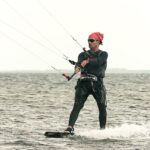
The Challenges of Learning to Stand on a Twin tip or kite Board.
Learning to stand on a kiteboard is an exhilarating experience but can also be challenging. Kiteboarding is a thrilling sport that requires physical strength, balance, and technique. With the proper instruction and practice, anyone can learn to stand on a kiteboard and enjoy the freedom of gliding across the water.
Understanding the Basics of Kiteboarding.
This article will discuss the challenges of learning to stand on a kiteboard and provide tips for overcoming them. With the right attitude and dedication, you can learn to stand on a kiteboard and experience the joy of mastering this thrilling sport.
Kiteboarding is an exhilarating sport that has gained popularity over the past few years. It combines wakeboarding, surfing, and kite flying, and it is a great way to get out on the water and enjoy the outdoors.
Kiteboarding is a sport that requires a lot of skill and knowledge, so it is essential to understand the basics before you get started. The first step is to choose the right kite. Kites come in a variety of sizes and shapes, and each one is designed for different wind conditions and skill levels. Choosing a kite appropriate for your skill level and the requirements you will be riding in is essential.
Once you have chosen your kite, you must learn how to fly it. Kiteboarding involves controlling the kite with the use of a bar or lines. The bar is attached to the kite and is used to manage the kite’s direction and speed. The lines are connected to the bar and control the kite’s power.
Once you have mastered the basics of flying a kite, you can move on to the next step: learning how to ride the board. Kiteboarding involves riding a board attached to the kite with a harness. The harness transfers the kite’s power to the board, allowing you to ride across the water.
Kiteboarding is a great way to get out on the water and enjoy the outdoors. Understanding the basics before you start is essential for a safe and enjoyable experience. You can quickly become a skilled kiteboarder with the right equipment and a little practice.
Developing the Necessary Skills to Stand on a Kiteboard.
Kiteboarding is an exciting sport that has been gaining popularity in recent years. It requires a combination of strength, agility, and balance to master, and the necessary skills to stand on a kiteboard can be developed with practice and dedication.
Twin tip vs. kite Board: The first step in learning to kiteboard is to become familiar with the equipment. Kiteboards are similar to wakeboards, but they are designed to be used with a kite, which is a giant inflatable kite that is attached to the rider’s harness. The kite generates power and lift, allowing the rider to glide across the water. Understanding the basic principles of kiteboarding before attempting to stand on a kiteboard is essential.
Once the rider is familiar with the equipment, practicing basic kiteboarding techniques is next. This includes learning how to launch and land the kite, control the kite’s power and direction, and use the board to turn and maneuver. Practicing these techniques in a safe environment, such as a shallow, protected body of water, is essential.
Once the rider is comfortable with the basic techniques, they can practice standing on the kiteboard. This requires balance, coordination, and the ability to maintain control of the kite. It is essential to start slowly and practice in shallow water, gradually increasing the difficulty as the rider becomes more comfortable.
It is also essential to practice proper safety techniques while kiteboarding. This includes wearing a life jacket, helmet, and other protective gear and following all local laws and regulations. Knowing the weather and wind conditions, which can affect the kite’s performance, is also essential.
Developing the necessary skills to stand on a kiteboard takes time and dedication, but anyone can learn to kiteboard with practice and patience. Once the rider has mastered the basics, they can move on to more advanced tricks and maneuvers and enjoy the thrill of kiteboarding.
Overcoming Fear and Building Confidence.
Fear can be an overwhelming emotion that paralyzes us and keeps us from achieving our goals. Moving past our fears and building confidence can be challenging, but it is possible.
By understanding the sources of our fear and taking action to overcome it, we can learn to trust ourselves and build the confidence we need to achieve our goals.
Fear can come from a variety of sources. It can result from past experiences, a lack of knowledge or understanding, or a fear of the unknown. Fear of failure or success can also cause it. No matter the source, anxiety can be debilitating and keep us from reaching our full potential.
The first step in overcoming fear and building confidence is to identify the source of the anxiety. Once the source is identified, it is essential to understand why it is causing fear. This can provide insight into how to address the fear and take action to move past it.
Once the source of the fear is identified, it is essential to take action to address it. This can include learning more about the start of the fear, developing strategies to manage the anxiety, or seeking help from a professional. Taking action can help to reduce fear and build confidence.
It is also important to practice self-care when overcoming fear and building confidence. This can include getting enough sleep, eating a healthy diet, and engaging in joyful activities. Taking care of oneself can help to reduce stress and increase feelings of self-worth, which can help to reduce fear and build confidence.
Finally, practicing positive self-talk when overcoming fear and building confidence is essential. This can include affirming statements such as “I am capable” or “I can do this.” Practicing positive self-talk can help to reduce fear and build confidence.
Overcoming fear and building confidence can be complex, but it is possible. By understanding the source of the anxiety, addressing it, practicing self-care, and engaging in positive self-talk, we can learn to trust ourselves and build the confidence we need to achieve our goals.
Choosing the Right Kiteboard and Equipment.
Choosing the right kiteboard and equipment is essential for having a safe and enjoyable kiteboarding experience. Kiteboarding is an exciting and exhilarating sport, but it is also dangerous and requires the right equipment and knowledge to stay safe.
The first step in choosing the right kiteboard and equipment is to determine what type of kiteboarding you plan to do. Different types of kiteboarding require different kinds of kiteboards and equipment. Freestyle kiteboarding requires a light and maneuverable board, while wave kiteboarding requires a more stable and durable board.
Once you have determined your kiteboarding plan, you can look for the right kiteboard and equipment. Kiteboards come in various shapes and sizes, and the size and shape of the board will depend on your weight, height, and skill level. Choosing a board that is the right size and profile for you is essential, as a board that is too small or too large can be challenging to control.
In addition to the kiteboard, you will also need to choose the right kite and bar. Kites come in various sizes and styles, and the size and style of the kite will depend on the type of kiteboarding you plan to do. Kite bars come in different sizes and techniques, and choosing a bar that is the right size and style for your kite is essential.
Finally, you will need to choose the proper safety equipment. Kiteboarding can be dangerous, so it is essential to have the appropriate safety equipment. This includes a helmet, life jacket, impact vest, and a kite leash. It is also necessary to have a spotter with you when you are kiteboarding, as they can help you stay safe and ensure you follow the rules of the sport.
Choosing the right kiteboard and equipment is essential for having a safe and enjoyable kiteboarding experience. Selecting a board with the right size and shape, the right kite and bar for the kiteboarding you plan to do, and the proper safety equipment is crucial. You can have a safe and enjoyable kiteboarding experience with the right equipment and knowledge.
Navigating Wind and Weather Conditions.
Navigating wind and weather conditions is an essential skill for any sailor. Knowing how to read the weather and anticipate changes in wind and sea conditions can help sailors make informed decisions and stay safe while on the water.
The wind is one of the most important factors to consider when navigating. Wind speed and direction can affect a boat’s course, and strong winds can create hazardous conditions. Before setting out, sailors should check the wind forecast and plan their route accordingly. If winds are strong, it is essential to take extra precautions and be prepared for sudden changes in direction.
Weather conditions can also have a significant impact on navigation. Rain, fog, and storms can all affect visibility and make it difficult to see obstacles or other vessels. Sailors should be aware of the forecast and be prepared for sudden weather changes. They should also be aware of any weather warnings that may be in effect and adjust their course accordingly.
In addition to wind and weather, tides and currents can also affect navigation. Surges can cause a boat to drift off course, while currents can make it challenging to maintain a steady speed. Sailors should know the tide and current forecasts and plan their routes accordingly.
Navigating wind and weather conditions can be challenging, but with the proper knowledge and preparation, it can be done safely and successfully. By staying informed and being prepared for sudden changes, sailors can ensure their journey is safe and enjoyable.
Learning to stand on a kiteboard is a challenging yet rewarding experience. You can become a proficient kiteboarder with the proper instruction, equipment, and practice. The key is to take it slow and practice safety at all times. With patience and dedication, you can master the art of kiteboarding and enjoy the thrilling experience of gliding across the water.
Excerpt.
Learning to stand on a kiteboard can be a challenging process. It requires knowledge of kiteboarding safety, the ability to read wind conditions, and the physical strength to maneuver the kiteboard. It is essential to have a qualified instructor to help you learn the basics and stay safe.
Author
Latest entries
 WatersportsMay 10, 2023Qatar GKA Freestyle Kite World Cup, Fuwairit Kite Beach, Qatar: 31 January – 04 February – 2023
WatersportsMay 10, 2023Qatar GKA Freestyle Kite World Cup, Fuwairit Kite Beach, Qatar: 31 January – 04 February – 2023 WatersportsMarch 30, 2023Seven Navigation Tips That All Kite Surfers Should Know.
WatersportsMarch 30, 2023Seven Navigation Tips That All Kite Surfers Should Know. WatersportsMarch 30, 2023Why Safety First is the Most Important Aspect of Kitesurfing.
WatersportsMarch 30, 2023Why Safety First is the Most Important Aspect of Kitesurfing. WatersportsMarch 30, 2023Tips to Improve Your Body Drag Skills in Kitesurfing.
WatersportsMarch 30, 2023Tips to Improve Your Body Drag Skills in Kitesurfing.




